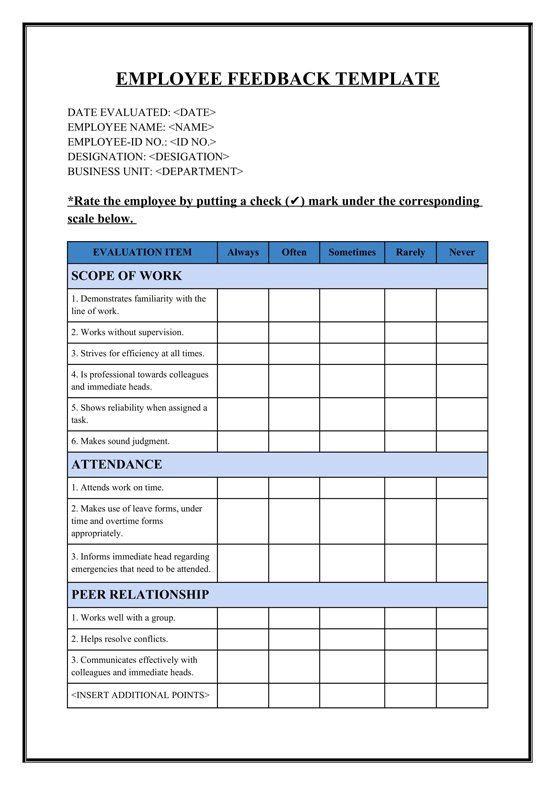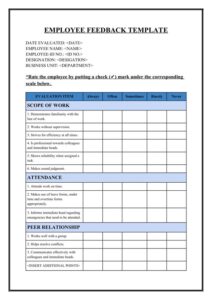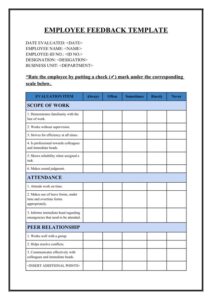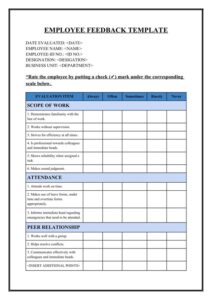Are you looking to empower your team members with valuable insights into their performance and development? Implementing a robust 360-degree feedback program is one of the most effective ways to foster a culture of continuous growth within your organization. It’s not just about annual reviews; it’s about creating a rich, multi-dimensional view of an individual’s strengths and areas for improvement, gathered from their peers, managers, direct reports, and even external stakeholders.

However, simply deciding to do 360-degree feedback isn’t enough. The quality of the insights you gain hinges heavily on the structure and content of your survey. That’s where a well-designed 360 degree feedback survey template becomes indispensable. It provides a standardized yet flexible framework, ensuring you ask the right questions to gather truly actionable feedback, without having to reinvent the wheel every time.
Crafting the Perfect 360 Degree Feedback Survey
Designing a survey that truly captures meaningful insights can feel like a daunting task, but it doesn’t have to be. The key is to approach it with a clear understanding of your objectives. Are you focused on leadership development, team collaboration, communication skills, or perhaps all of the above? Your goals will dictate the types of questions you need to include, ensuring that the feedback is relevant and can be directly applied to individual and team growth plans. Think about the specific behaviors and competencies you want to assess.
Once your objectives are crystal clear, the next step is to formulate questions that are specific, observable, and non-leading. Vague questions often yield vague answers, which aren’t very helpful for development. Instead of asking, “Is John a good leader?”, try something like, “How effectively does John delegate tasks to empower his team members?” This prompts the rater to reflect on observable actions and provide more precise feedback. Ensure a mix of open-ended questions for qualitative insights and scaled questions for quantitative data, allowing for both depth and easy comparison.
A comprehensive 360-degree feedback survey template typically covers several key competency areas. It’s important to provide a balanced view, addressing various aspects of an employee’s professional life. This multi-faceted approach ensures that the feedback is holistic and provides a well-rounded picture of performance and potential.
Essential Competency Areas to Include:
- Leadership and Management Skills: Questions focusing on delegation, decision-making, strategic thinking, and team motivation.
- Communication: Encompassing listening skills, clarity in expressing ideas, written communication, and ability to foster open dialogue.
- Teamwork and Collaboration: Assessing contributions to group projects, willingness to help others, conflict resolution, and overall team spirit.
- Problem-Solving and Innovation: Evaluating critical thinking, adaptability to change, creativity in solutions, and proactive identification of issues.
- Personal Effectiveness: Including time management, accountability, reliability, professionalism, and commitment to personal growth.
- Customer Focus (Internal/External): If applicable, questions related to responsiveness, service quality, and understanding stakeholder needs.
By structuring your 360 degree feedback survey template around these core areas, you ensure a thorough evaluation. Remember to also include a section for general comments or suggestions, as this often unearths valuable insights that might not have been captured by specific questions. Testing your template with a small group before wider deployment can also help iron out any ambiguities or identify areas for improvement in the survey itself.
Implementing and Utilizing Your 360 Degree Feedback
Once you have a fantastic 360 degree feedback survey template ready to go, the implementation process is crucial for its success. Transparency and clear communication are paramount from the very beginning. Explain to all participants, both those being reviewed and those providing feedback, the purpose of the exercise, how the data will be used, and most importantly, the assurance of anonymity for feedback providers. This builds trust and encourages honest, constructive responses. It’s also wise to set clear timelines and provide instructions on how to complete the survey to ensure a high participation rate.
After collecting all the responses, the real work of analysis begins. Avoid the temptation to just skim the feedback. Instead, look for patterns and recurring themes across different raters. Are there consistent strengths highlighted by multiple colleagues? Are certain areas for development mentioned by a manager, a peer, and a direct report? This triangulation of data gives you a much clearer and more reliable picture than relying on just one or two responses. Focus on actionable insights rather than general criticisms.
Delivering the feedback to the individual is perhaps the most sensitive part of the process. It’s not a moment for judgment, but for coaching and development. Managers or HR professionals should be trained to facilitate these conversations, focusing on a growth mindset. Start by acknowledging the individual’s strengths, then discuss areas for development using specific examples from the feedback. Help the employee understand the “what” and “why” behind the feedback, and guide them in formulating a personal development plan based on these insights.
Finally, integrating the 360-degree feedback into broader talent management initiatives elevates its impact. This isn’t a one-off event; it’s a tool for continuous improvement. Use the insights to identify training needs across teams, inform succession planning, or even refine your company’s competency models. By consistently leveraging this rich data, organizations can foster a culture where feedback is seen as a gift, driving both individual career progression and overall organizational excellence.
A well-executed 360-degree feedback process, powered by a thoughtful survey design, can truly transform how individuals and teams grow within your organization. It moves beyond traditional top-down appraisals, creating a more comprehensive and nuanced understanding of performance that comes from multiple perspectives.
By empowering your people with this rich, multi-source insight, you’re not just evaluating past performance; you’re actively investing in their future capabilities and fostering a dynamic environment where everyone is continuously learning and evolving. This commitment to development ultimately strengthens your entire workforce, preparing them for future challenges and opportunities.


